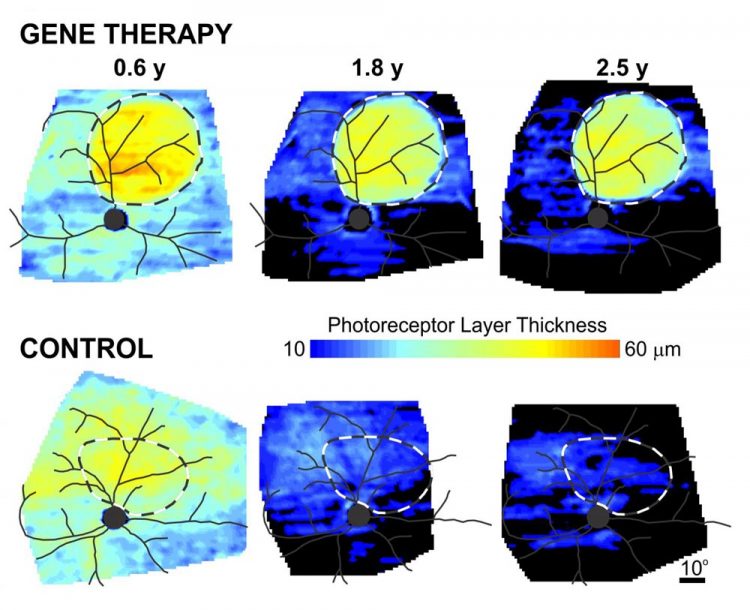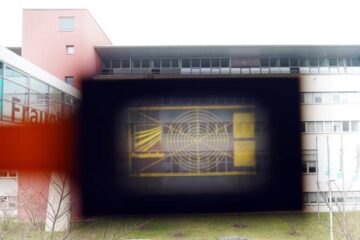Penn study stops vision loss in late-stage canine X-linked retinitis pigmentosa

Using gene therapy to augment normal levels of the RPGR gene resulted in long-term rescue of photoreceptors within the retinal region of gene therapy injection, but not within the control injection. The rescue lasted at least 2.5 years when the disease was treated in its later stages. Credit: University of Pennsylvania
Because the disease affects humans in almost the same fashion as it does dogs, the results suggest that this treatment could be effective and lasting in humans and could set the stage for safety studies that precede a human clinical trial.
“The 2012 study showed that gene therapy was effective if used as a preventive treatment or if you intervene right after the onset of cell death,” said William A. Beltran, co-lead author and associate professor of ophthalmology at Penn's School of Veterinary Medicine.
“That was obviously very encouraging. But now we've gone further, showing that the treatment is long-lasting and effective even when started at mid- and late-stage disease.”
“This happens to be a very severe disease with very early onset in the first two decades of life in humans,” said Artur V. Cideciyan, co-lead author and research professor of ophthalmology in the Scheie Eye Institute at Penn's Perelman School of Medicine. “Because the progression of disease in dogs matches up with the progression in humans, this gives us a lot of confidence about translating these results to eventually treat humans.”
The work involved a close collaboration between Beltran and Cideciyan as well as Samuel G. Jacobson, professor of ophthalmology at Scheie, and Gustavo D. Aguirre, the paper's senior author and professor of medical genetics and ophthalmology at Penn Vet. The Penn researchers have also long partnered with University of Florida scientists led by William Hauswirth, Rybaczki-Bullard Professor of Ophthalmology in the College of Medicine.
Their work appears in Proceedings of the National Academy of Sciences.
X-linked retinitis pigmentosa, or XLRP, arises primarily from mutations in the RPGR gene, leading to progressive vision loss starting at a young age. Because it is an X chromosome-linked recessive disease, it overwhelmingly affects boys and men. It is one of the most common forms of inherited retinal disease.
Though rigorously studied, little is understood about the function of RPGR. It is believed to play a role in the function of the connecting cilium, a structure that is present in both rod and cone cells, the photoreceptor cells involved in dim-light and bright-light vision, respectively.
In XLRP, these photoreceptor cells progressively degenerate and die. To counter this effect, the Penn group's earlier gene therapy work used a viral vector to deliver a normal copy of RPGR specifically to rods and cones using a subretinal injection.
In the new publication, the team reports that the therapy, which occurred when dogs were 5 weeks old, successfully stopped photoreceptor cell loss and maintained vision in dogs for more than three years of study.
This study also went further, using the same viral vector and same approach, except this time beginning the gene therapy intervention at two later time points: At 12 weeks of age, which the researchers term “mid-stage disease,” when approximately 40 percent of the eye's photoreceptor cells have already died, or at 26 weeks of age, “late-stage disease,” when about 50 to 60 percent of the rods and cones were lost.
The team had concerns about treating at these later stages, both that the retina might not properly reattach following the therapeutic subretinal injection and that there could be toxicity from the viral vector due to the greater extent of photoreceptor cell degeneration. They saw no indications of either being a problem in their follow-up.
“We have spent a lot of time working to make sure the therapeutic gene is tightly regulated in terms of when and where it is expressed,” said Aguirre. “And, thankfully, we have seen that this therapy appears to be well tolerated in the retina.”
Instead, what they saw, using non-invasive tests used in human medicine, including electroretinography and optical coherence tomography imaging, was a remarkable and lasting halt in the degeneration of photoreceptor cells in the treated region of the retina. Dogs treated at these later stages of disease even had some of the structural abnormalities in the rods and cones reversed. And these findings translated to improved performance on visual behavior tests, a Y maze that tested whether the dogs could detect a dim light and an obstacle course that assessed their visual navigational skills. The dogs' performances endured for at least two and a half years after treatment, the latest time point examined, in the late-stage group.
“What the dog studies show, especially those that are treated at a later stage, is that you can treat a relatively small region — 20 percent or less of the retinal surface, where you already had 50 percent of photoreceptor cells that died before treatment — and still see not only an electrophysiological improvement and rescue but an actual rescue of visual behavior,” Beltran said.
“Based on my experience developing gene therapies in animal models for many other inherited retinal diseases,” said the University of Florida's Hauswirth, “I believe this report describes perhaps the strongest case yet for eventual successful therapy in humans for XLRP.”
As in their earlier work, the researchers showed that the function of both rods and cones was rescued and that these photoreceptor cells were properly connected to the neurons that transmit visual signals to the brain.
“Because this is a photoreceptor disease that affects both rods and cones, or night and day vision cells, to show that both were rescued was very wonderful to see,” Cideciyan said.
“I worry a lot about my patients who have lost photoreceptor cells and possibly have abnormal connectivity and structure in their retina, whether gene therapy would still work for them at later stages of disease,” Jacobson said. “What we showed here is that the therapy resulted in downstream neurons that were robust and connected, which is exceptionally important for eventual human treatment.”
To move the work into the realm of human treatment, the researchers are examining patients to determine where in the retina may be a suitable place for injection and what patients might qualify for an eventual clinical trial. They are also studying the other genetic “partners” that function along with RPGR in the connecting cilium to see if there could be additional targets for therapy.
###
In addition to Beltran, Cideciyan, Aguirre, Jacobson and Hauswirth, the research was conducted by Penn Vet's Simone Iwabe, Kendra McDaid and Inna Martynyuk; Penn Medicine's Malgorzata Swider, Mychajlo S. Kosyk, Gui-shuang Ying and James Shaffer; and UF's Wen-Tao Deng, Sanford L. Boye and Alfred S. Lewin.
The research was supported by the National Institutes of Health, the Foundation Fighting Blindness, the Macula Vision Research Foundation, Hope for Vision and the Van Sloun Fund for Canine Genetic Research.
Media Contact
All latest news from the category: Health and Medicine
This subject area encompasses research and studies in the field of human medicine.
Among the wide-ranging list of topics covered here are anesthesiology, anatomy, surgery, human genetics, hygiene and environmental medicine, internal medicine, neurology, pharmacology, physiology, urology and dental medicine.
Newest articles

Advanced Brain Science Without Coding Expertise
Researchers at Helmholtz Munich and the LMU University Hospital Munich introduce DELiVR, offering a new AI-based approach to the complex task of brain cell mapping. The deep learning tool democratizes…

Transparent emissive microdisplays
… for ultra-light and compact augmented reality systems. As part of the HOT project (High-performance transparent and flexible microelectronics for photonic and optical applications), scientists from the Fraunhofer Institute for…

Bringing bio-inspired robots to life
Nebraska researcher Eric Markvicka gets NSF CAREER Award to pursue manufacture of novel materials for soft robotics and stretchable electronics. Engineers are increasingly eager to develop robots that mimic the…





















